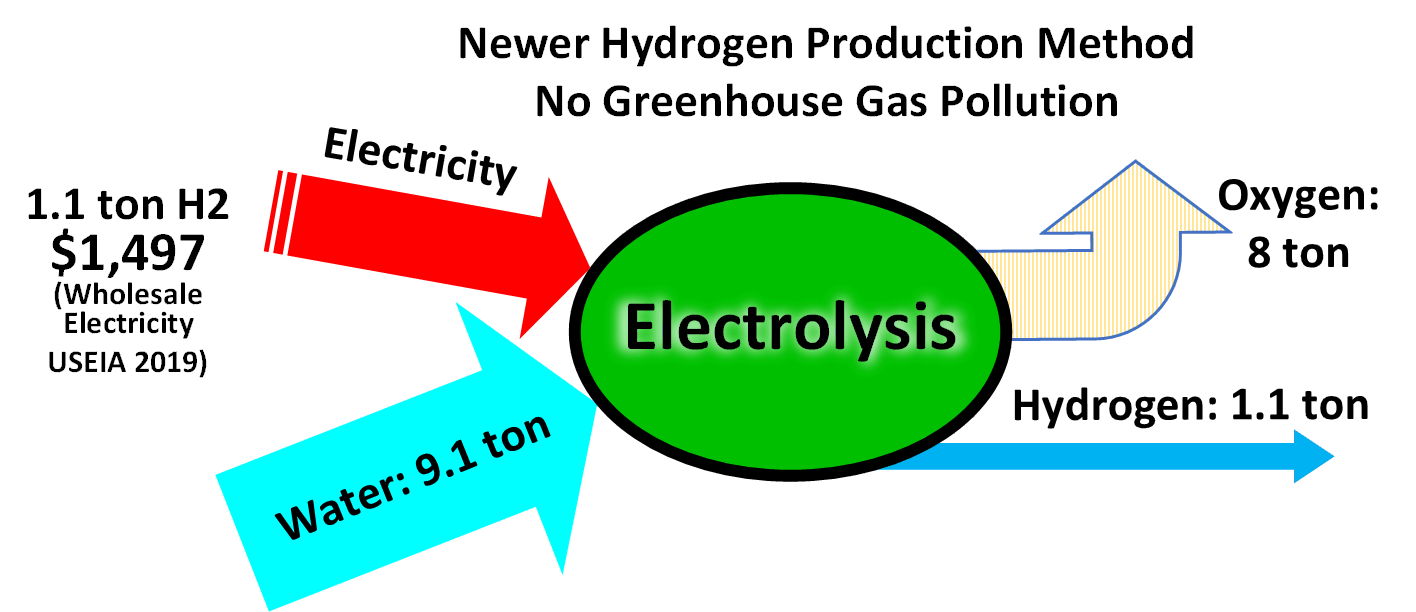
Water flowing over iron rock releases hydrogen. The process takes place in Earth’s crust. Image: “Waterfall” Alps, by Jiri Bubenicek. Creative Commons 4.0. Included with appreciation.
Water is the most abundant element not just on Earth but in the universe. Water contains hydrogen – an energy source that is not only powerful (think rocket fuel) but clean: when you burn it, the only emission is water, because water is H2O.

Water is H2O. Image: “Water Molecule,” by Booyabazooka, 2006. Dedicated by the artist to the public domain, CCO 1.0, and included with appreciation.
In the quest for clean energy, hydrogen has not quite led the pack because it is currently produced in ways that are not so clean. We can generate hydrogen from water, but that process takes a lot of electricity. We can generate hydrogen from methane, but CO2 escapes.

Graphic of industrial process showing inputs into electrolysis to produce one ton of hydrogen and other outputs. By Parent55, 2020. Dedicated by the artist to the public domain, CCO 1.0, and included with appreciation.
Now, geologists and scientists may have found a way to access hydrogen in the same way we now drill for oil. There is hydrogen in the Earth’s crust. Some estimates indicate millions of megatons of hydrogen. It is true that, for distribution, hydrogen would have to be liquified to flow through conduits like the Alaska pipeline: there are some problems with that approach, but proposals to mix it with other substances might work. Another option is compression. The great benefit from mined hydrogen is that we could use the same equipment we already have, the same technologies, the same trained specialists. The fossil fuel industry’s existing infrastructure would be reused, renewed, and reborn.

“An elevated section of the Alaska Pipeline” 2007. U.S. Department of Transportation Public Domain. Included with appreciation.
Hydrogen may be the ultimate renewable energy. Geologists find that hydrogen is constantly being generated by Earth’s normal interaction of water with iron-laden rock. As water flows past rock, iron grabs the oxygen and the result is hydrogen. That’s why hydrogen may always be renewing through Earth’s natural processes.

“Banded iron formation at Dales Gorge, Karijini National Park, Western Australia,” 2013, by photographer Graeme Churchard. Creative commons 2.0. Included with appreciation.
And, also, good news for NASA. Because water and iron-rock are present in other areas of the universe, like planets and asteroids, hydrogen may be accessible in space.

“The Celestial Zoo” by Pablo Carlos Budassi, 2022. Infographic listing 210 notable astronomical objects on a central logarithmic map of the observable universe. Wikimedia commons 4.0. Included with appreciation.
Hydrogen formed by Earth’s interaction of water and rock is as old as waterfalls and aquifers and as new as rockets. We may be standing on the ultimate source of renewing the world.

Image by Caleb Ralston, 2015. Dedicated to the public domain CCO 1.0 by the photographer; included with appreciation.
Coy, Peter. “A Gold Mine of Clean Energy May Be Hiding Under Our Feet.” 27 February 2023. The New York Times. https://www.nytimes.com/2023/02/27/opinion/hydrogen-natural-climate-change.html?smid=nytcore-ios-share&referringSource=articleShare
Ellis, Geoffrey, and Sarah E. Gelman. “A preliminary model of global subsurface natural hydrogen resource potential.” 12 October 2022. Geological Society of America. Paper: 215-5. Geological Society of America Abstracts with Programs, Volume 54, No. 5, 2022. doi: 10.1130/abs/2022AM-380270. https://gsa.confex.com/gsa/2022AM/meetingapp.cgi/Person/266148
Building the World Blog by Kathleen Lusk Brooke and Zoe G. Quinn is licensed under a Creative Commons Attribution-NonCommercial-NoDerivs 3.0 Un

